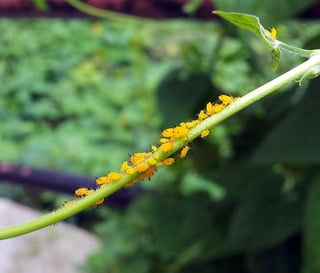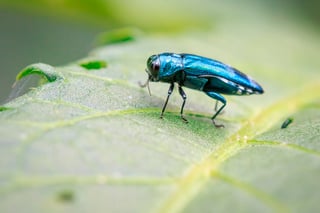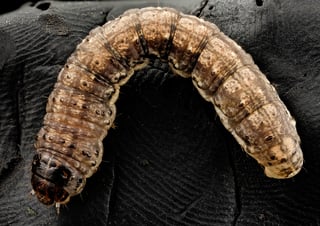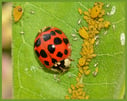 Copyright: radub85 / 123RF Stock Photo
Copyright: radub85 / 123RF Stock Photo
Spring insects bugging you? The last thing we want to worry about are insects wreaking havoc on our raised bed full of growing edibles or attacking the leaves, buds, and flowers on our majestic palm trees. After all, our landscape trees and plants are starting to burst with life, and we are looking forward to watching the tender young leaves expanding to create shade on our lawn. Luckily, there are ways to keep away these unwelcome visitors. We can help!
Spring Insects List Common in Our Area
 Whiteflies: You have probably seen those little white flying bugs on your plants and wondered what they are. They are Whiteflies, and these soft-bodied, winged insects tend to suck on ornamentals and warm-weather vegetable plants such as tomatoes, peppers, and plants from the cabbage family. You might also spot them in greenhouses.
Whiteflies: You have probably seen those little white flying bugs on your plants and wondered what they are. They are Whiteflies, and these soft-bodied, winged insects tend to suck on ornamentals and warm-weather vegetable plants such as tomatoes, peppers, and plants from the cabbage family. You might also spot them in greenhouses.
 Aphids: These pesky tiny bugs are often invisible to the naked eye and seem to make their way into every garden. Since they can multiply quickly, you will want to control them right away. They can feed on a wide variety of plants and attack leaves, stems, buds, flowers, fruit, and roots. There is good news – they tend to move very slowly and controlling them is easy.
Aphids: These pesky tiny bugs are often invisible to the naked eye and seem to make their way into every garden. Since they can multiply quickly, you will want to control them right away. They can feed on a wide variety of plants and attack leaves, stems, buds, flowers, fruit, and roots. There is good news – they tend to move very slowly and controlling them is easy.
 Borers: A borer can be a worm, mollusk, insect, or insect larva that bores into wood, other plant material, and even rock. Borers attack the leaves, buds, and flowers or palms. Borer infestations can be intense, and they can structurally weaken a palm tree.
Borers: A borer can be a worm, mollusk, insect, or insect larva that bores into wood, other plant material, and even rock. Borers attack the leaves, buds, and flowers or palms. Borer infestations can be intense, and they can structurally weaken a palm tree.
 Caterpillars and Cutworms: Cutworms are like caterpillars, are often mistaken for grubs, and can do the most damage when they emerge from hibernation during the early gardening season. They are commonly seen on a wide variety of vegetables and any fresh seedlings. They can do a lot of damage quickly. Caterpillars can be found chewing on some fruit trees, vegetables, as well as ornamental and shade trees. They like to snack on leaves and some tunnel into fruits.
Caterpillars and Cutworms: Cutworms are like caterpillars, are often mistaken for grubs, and can do the most damage when they emerge from hibernation during the early gardening season. They are commonly seen on a wide variety of vegetables and any fresh seedlings. They can do a lot of damage quickly. Caterpillars can be found chewing on some fruit trees, vegetables, as well as ornamental and shade trees. They like to snack on leaves and some tunnel into fruits.

Spider mites: These tiny sucking pests are often found on the undersides of plant leaves. They can attack both indoor and outdoor plants and are an issue with Cypress trees. They feed by piercing leaf tissue and sucking up the plant fluids.
Copyright: miyuki3 / 123RF Stock Photo
Spring Insects: Natural Remedies and More!
Whiteflies: Wander your landscape in the morning or evening and check the back of the leaves for eggs. As you are wandering and approaching plants, you may also notice little bugs flying away. Blast them with your watering hose. Doing this will cause them to scatter. Once you have blasted them with the water hose, spray your leaves (be sure to spray the undersides) with insecticidal soap and coat them. You will want to spray plants when the temperatures are cold. Note: doing this in the heat can cause an adverse reaction. Follow up several times.
- A good squirt of dishwashing liquid with lemon to a gallon of water should work well.
- You could always use a handheld vacuum and remove them every few days from your plants.
- The homemade mixture is pretty benign, and whiteflies can be challenging to get rid of, so consider using preventative methods too.
- Many organic farmers like to use Neem Oil; a vegetable oil pressed from the fruits and seeds of the neem tree.
 Prevent them from exploding in population by keeping natural predators such as beneficial insects like ladybugs and spiders.
Prevent them from exploding in population by keeping natural predators such as beneficial insects like ladybugs and spiders.- Hummingbirds are excellent predators too. You can attract hummingbirds by creating a beautiful natural habitat they will love.
- We have heard that mulching with an aluminum reflective material is helpful because it makes it harder for the whiteflies to find host plants. Do this early in the season.
- You can purchase Captain Jacks Dead Bug Brew at Moon Valley Nurseries (call to see if your local Moon Valley Nurseries has them in stock.)
Aphids: Sometimes getting rid of aphids is a breeze. In fact, you can blast them with a spray of cold water to get rid of them. Here are some other ways to get rid of these pests.
- If there is an invasion, you can constipate the pests by dusting plants with flour.
- You can spray aphids with insecticidal soap, horticultural oil, neem oil.
- Wiping or spraying the plants with a mild solution of water and a few drops of dishwashing detergent can also get rid of them.
- You can also stir together 1 quart of water, one teaspoon of liquid dish soap, and a pinch of cayenne pepper. We do not recommend diluting before spraying on the plants.Some people also have luck using homemade garlic or tomato-leaf sprays.
- Prevent them from feeding on fruit or shade trees by spraying dormant oil, which can eliminate overwintering eggs.
- Lady beetles, lacewings, and parasitic wasps are beneficial insects that feed on aphids.
- Aphid
 s are repelled by catnip, so it may be a good idea to plant catnip too (your feline companion will thank you!)
s are repelled by catnip, so it may be a good idea to plant catnip too (your feline companion will thank you!)
Borers: The larval stage damages plants by destroying the internal plant tissue as they feed and mature. Some borer species leave wood unstable because they can weaken the wood fiber and degrade the quality. Tree borers lay their eggs on or inside of trees.
- The best way to guard against borers is to keep trees healthy and vigorous.
- All borers go through a metamorphosis with four life stages – egg, larva, pupa and adult
- Use sticky traps and Pheromone Traps to attract and trap adult borers. Monitor them early and continue throughout the season.
- If there are larvae damaging plants, you can use Beneficial Nematodes mixed in an aqueous solution. Inject the solution into the borer entrance holes. Doing this can kill larvae within 48-72 hours.
- You can also use Horticultural or Dormant oil sprays. Use these sprays on possible egg laying sites when adults are present. These oils are excellent because they can smother the eggs, which can reduce borer populations in the next season.
Caterpillars and Cutworms: These pests can chew through plant stems at the base, and they feed primarily on the roots and foliage of young plants. They can even cut off the plant from underneath the soil.
- You can make plant collars by putting a 4-inch piece of cardboard around each plant stem. Doing this can help stop cutworms from reaching tender stems.
- Do this at night - Grab a flashlight, gloves, and hand pick them. Put the picked off cutworms into soapy water. You will want to repeat this every few nights.
- You can sprinkle used coffee grounds or place eggshells around your plants.

- Apply an insecticide late in the afternoon.
- A great way to prevent them is to keep up with cultivation. They prefer to lay eggs in high grass and weeds, so at the end of the season, you will want to plow or till your landscape and mow the surrounding areas. Doing this can expose cutworms
- You can prevent them with a beneficial insect such as fireflies. Fireflies are fun insects and are a natural predator to cutworms. and can destroy their winter habitat.
- Another natural predator to cutworms are birds, so create a bird-friendly landscape.
- Encourage native predators and parasites to control caterpillars.
Spider mites: These pests are difficult to see, that is until plant injury occurs. Visible signs include webbing as well as white or yellow speckles on leaves.
- Spider mites hate cold baths, so douse them with cold water that is between 32 degrees and 40 degrees. We recommend keeping a spray bottle in the refrigerator so that you can keep the water very cold. Mist them once or twice a day until the mites are gone.
- Y
 ou can also spray infested leaves with a solution of rosemary oil or a rosemary-oil pesticide.
ou can also spray infested leaves with a solution of rosemary oil or a rosemary-oil pesticide. - Purchase some Phytoseiulus persimilis mites. They are voracious predators of spider mites and are excellent beneficial predatory mites for controlling spider mites. Other beneficial insects include lady beetles and some arachnids.
- You can also spray a soapy solution of 3 tbsp. dishwashing soap squirted into a gallon of water. Use a spray bottle and apply to the foliage.
- One of the best ways to prevent spider mites is to boost the health of your plants. You can do this by providing the proper amounts of water and nutrients that your plants need.
For additional information on how to prevent and control pests visit your nearest Moon Valley Nurseries location and speak with our on-site nursery pros.


Submit a Comment